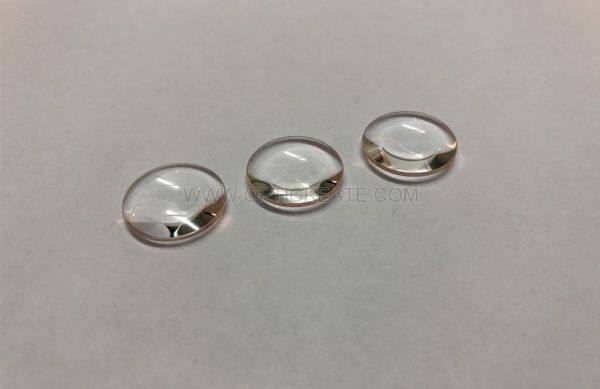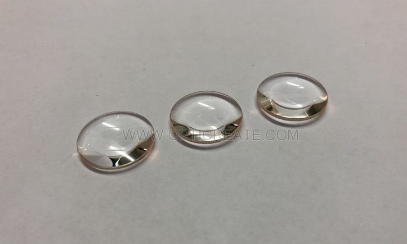Company News

The Bi-convex lens is a kind of double convex lens sheet, which includes the incident plane and the radial plane. The Bi-convex lens sheet is characterized by a long focal length in the middle part of the lens surface and a short focal length at the end of each lens surface. Bi-convex lens is used to concentrate light from point sources or to transfer images to other optical systems. The Bi-convex lens is a kind of Bi-convex lens sheet, which includes the incident plane and the radial plane. The Bi-convex lens sheet is characterized by a long focal length in the middle part of the lens surface and a short focal length at the end of each lens surface. Bi-convex lens is used to concentrate light from point sources or to transfer images to other optical systems.

A convex lens is a lens with a thin edge and a thick middle. One side of a convex lens must be convex, convex lens according to the other side is convex, plane, concave three cases are the double convex lens, flat-convex lens, convex-concave lens. In life, most of our common magnifying glasses are double convex lenses. Convex lenses have an aggregation effect on light. The straight line passing through the center of two aspects of the lens is called the main optical axis of the lens. The formula of convex lens imaging is, where is the object distance, is the image distance and is the focal length. Under different conditions of convex lens imaging classification, and handstand to reduce the real image, and handstand big realities, such as inverted magnified real image, not imaging, and state of amplification of virtual image theory of convex lens imaging belongs to the content of refraction in optical part, belong to often use the knowledge in the field of optical, in the field of optics, convex lens device is also widely used.
How does a convex lens work?A convex lens has a magnifying effect. The convex lens is divided into two focal lengths, and one focal length is divided into real and imaginary positive and inverted.
Parallel light (like the sun) parallel to the main optical axis (convex lens two spherical globe attachment referred to as the main axis of the lens) into the convex lens, the light on both sides of the lens after two refractions, focused on a point on the shaft, which is called the focus of the convex lens (mark for F, English for focal point), the convex lens in the mirror on each side of a real focus, such as thin lens, the two focal distance roughly equal to the center of the lens. The focal length of a convex lens is the distance from the focus to the center of the lens, usually expressed as f. The smaller the spherical radius of a convex lens, the shorter the focal length. A convex lens can be used for magnifying glass, glasses for presbyopia and hyperopia, camera, movie projector, slide projector, microscope, telescope lens, etc.
Principal axis: the line that passes through the two spherical centers C1.C2 is called the principal axis of a convex lens. Center of light: the center O of a convex lens is the center of light of the lens. Focal point: light rays parallel to the principal axis pass through the convex lens and converge on the principal axis at a point F, which is the focal point of the convex lens. Focal length: the distance from the focal point F to the center of a convex lens O is called the focal length, expressed as F. Distance: the distance between the object and the center of light of a convex lens. Image distance: the distance from the image of an object through a convex lens to the center of light of a convex lens is called an image distance, denoted by v.
In fact, neither convex lens nor a concave lens has a certain focus, and only light rays parallel to the main axis, and the same distance from the main axis will completely intersect on the main axis. The reason why we see that many rays passing through a convex lens parallel to the main axis but at unequal distances from the main axis have a "focal point" is because the convex lens has a larger radius of curvature and no significant difference in the degree of light deflection. For ease of use, the focal point of a convex lens is the intersection of two rays at the same distance from the main axis of light and from the top of the lens.
-
Optical Objective for Endoscope Repair and Maintenance
-
Rod Lens for Storz Endoscope Repair and Maintanience
-
Hysteroscpe Objective for Storz/ Stryker, etc. Endoscope Repair and Maintenance
-
Cystoscpe Objective for Storz/ Stryker, etc. Endoscope Repair and Maintenance
-
Laparoscope/ Arthroscope/ Hysteroscope Rod Lens for Storz Endoscope Repair and Maintanience
-
Arthroscope Objective for Storz/ Stryker, etc. Endoscope Repair and Maintenance
-
Window Tint Meter DB22-TM273/OEM/ODM
-
Light Transmittance Meter DB22-TM275/DB22-TM275P/DB22-TM275P6
-
Rod Lens Borosilicate Glass Rod
-
Ar Coating Bk7 15mm Plano Concave Cylindrical Lens for Imaging
-
Ar Coating Bk7 Dome Glass Lens for Underwater Protection
-
polarizer,Anomalous lens,conductive glass,seal glass,Defrosting conductive lenses
-
Super-large mirror,Super curved mirror,super spherical mirror
-
plano-convex lens,optical lens,prism,roof prism,double convex lens,concave lens
-
spectroscopeï¼ plane mirror, optical mirror
-
free-form mirror,spherical mirror, aspherical mirror, plane mirror, optical mirror
-
High-quality Optical Components Made of Sapphire And Quartz
-
High-quality Sapphire Plate With OEM Specification
-
High-quality Sapphire Tip With OEM Specification
-
High-quality Sapphire Step With OEM Specification
-
High-quality Sapphire Window With OEM Specification
-
High-quality Sapphire Windows With OEM Parameters
-
Customized Beam Splitting Optical Cube Prisms
-
Prism CMY Cube Optical Glass K9 Cubic Prism, Satellite Assembly Precision Measuring Mirror
Popular Searches
- optical mirror
- bk7 optical glass blanks
- acrylic google cardboard biconvex lens
- laser mirror
- large plastic fresnel lens
- parabolic mirror
- cylindrical achromat
- Small Lens
- angel eyes projector lens
- fly eye lens
- dielectric mirror
- optical mirrors
- laser mirrors
- Usb Lens
- laser reflection mirror
- Laser Reflective Mirror

